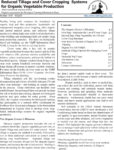The educational materials listed on this page are about Ridge Tillage.
Ridge tillage is a form of conservation tillage where the farmer builds ridges or raised beds. Planting is completed on the ridge and usually involves the removal of the top of the ridge. Ridge tillage can improve soil health, reduce erosion and runoff. This conservation tillage system is preferable for cold and wet soils because raised beds provide better drainage and a warmer environment. Weed management is easier in ridge-tilled systems since mechanical weed control can be employed here. Wide ridges are an option for conventional and organic vegetable farmers who are interested in reducing tillage. Using cover crops in ridge-till systems is also an option. Once the cover crop is mowed, the seed bed should be scraped off in preparation for seeding.
Showing 1-2 of 2 results

Reduced Tillage and Cover Cropping Systems for Organic Vegetable Production
This information sheet captures research by Virginia Tech and the Virginia Association for Biological Farming to develop cover crop-based, reduced-tillage systems for organic vegetable production.

Steel in the Field
Weed control demands time, labor and expense for every farmer every year. Steel in the Field shows how today's implements and techniques can control weeds while reducing—or eliminating—herbicides. Available only online.